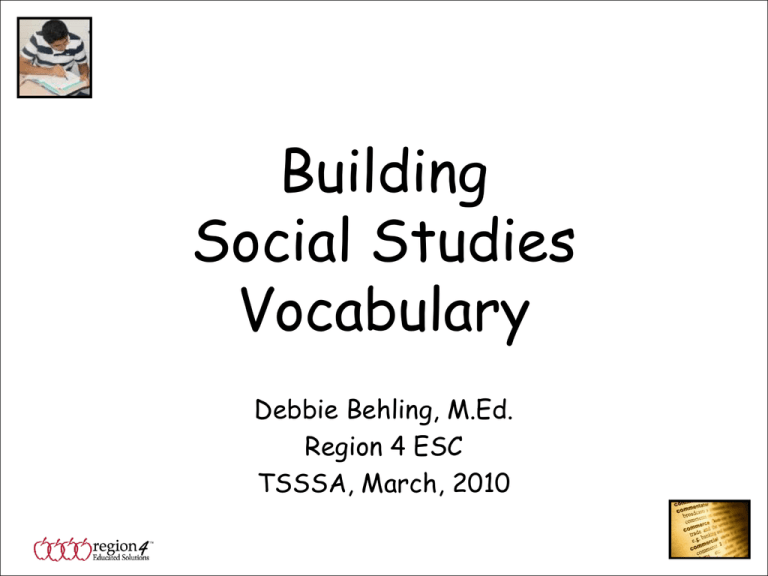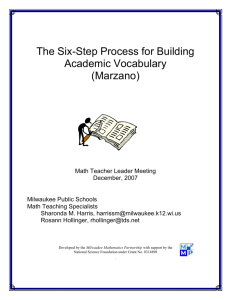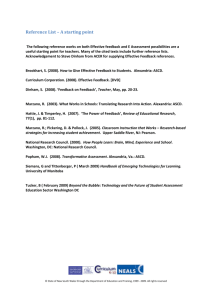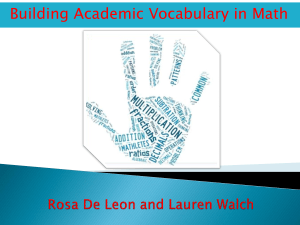Building SS Vocabulary PPT
advertisement

Building Social Studies Vocabulary Debbie Behling, M.Ed. Region 4 ESC TSSSA, March, 2010 Handout Page 1 Today’s Objectives • Explore research-based strategies in a social studies context that support academic vocabulary development. • Experience hands-on activities and take classroom-ready applications for immediate implementation. Handout Page 1 Activity 1 Think-Pair-Share How do teachers deliver vocabulary instruction to their students? – – – – What strategies do they use? How effective are these strategies? How do we know if these strategies are effective? What part does background knowledge play in learning new vocabulary? Consider… • Teach specific terms in specific ways. • Select academic vocabulary terms strategically. • Build background knowledge where needed before teaching vocabulary. Relative Reading Level Estimated Effect of Academic Background Knowledge (ABK) on Reading Levels Handout Page 2 Without ABK With ABK Kinder Grade 3 Grade 8 Grade 11 Handout Page 2 Assessment Measurement Results of Direct Vocabulary Instruction as Measured by Standardized Tests 90% 80% 83% 70% 60% 50% 40% 50% 30% 20% 10% 0% No DVI With DVI Direct Vocabulary Instruction (DVI) Crisis of Literacy • Annual drop-out rate – 3,000 • Plan for prison beds based on 4th grade reading scores Literacy and National Reading Statistics, Teaching Reading. Referenced by Kunjufu, J. Retrieved April 17, 2006, from Reading scores and prison growth: http://www.edu-cyberpg.com. “[It is critical that] students who do not come from academically advantaged backgrounds [receive] systematic instruction in important academic terms.” *Marzano, R. & Pickering, D. (2005). Building Academic Vocabulary: Teacher’s Manual. ASCD, Alexandria, p. 3 District Vocabulary List Creating a Vocabulary List • Choose a list of 10 words you believe are critical to your content area and course. • Explore your content and grade level TEKS. • Refine your list of 10 words you believe are critical to your content area and course. Handout Page 3 Activity 2 Five Phases: Creating a List of Academic Terms • Read the five phases for developing district-wide vocabulary on page 3. • Consider your district’s status in this development process. • What obstacles have you faced in accomplishing this task? Activity 3 Six Steps for Building Vocabulary • Use the strips to predict the order of the six steps for building academic vocabulary. • Why do you think they go in the order you chose? Handout Page 3 Six-Step Process For Teaching Academic Vocabulary* Steps 1-3: Introduce new term Steps 4-6: Provide multiple exposures Transformation *Marzano, R. & Pickering, D. (2005). Building Academic Vocabulary: Teacher’s Manual. ASCD, Alexandria, pp. 14-15 Activity 4 Interactive Lecture • Select a vocabulary word from your content area. • Choose one that students must know to understand a vital concept or skill. • Use this vocabulary word throughout the explanation of the six steps. • Be prepared to share with a partner. Handout Page 3 Six-Step Process For Teaching Academic Vocabulary* 1. Provide a description, explanation, or example of the new term. • • • • • Use multimedia to introduce Tell a story using the term Integrate current events Show a visual of the term Text Pattern Vocabulary (Activity 5) *Marzano, R. & Pickering, D. (2005). Building Academic Vocabulary: Teacher’s Manual. ASCD, Alexandria, pp. 14-15 Handout Page 3 Six-Step Process For Teaching Academic Vocabulary* 1. Provide a description, explanation, or example of the new term. Monarch - One who reigns over a state or territory, usually for life and by hereditary right, often with unlimited power; one example is a king. *Marzano, R. & Pickering, D. (2005). Building Academic Vocabulary: Teacher’s Manual. ASCD, Alexandria, pp. 14-15 Handout Page 3 Six-Step Process For Teaching Academic Vocabulary* 2. Ask students to restate the description, explanation, or example in their own words. Monarch – Someone who is in charge of a country *Marzano, R. & Pickering, D. (2005). Building Academic Vocabulary: Teacher’s Manual. ASCD, Alexandria, pp. 14-15 Handout Page 3 Six-Step Process For Teaching Academic Vocabulary* 2. Ask students to restate the description, explanation, or example in their own words. • Use an analogy: A monarch is to a country as a boss is to a business. *Marzano, R. & Pickering, D. (2005). Building Academic Vocabulary: Teacher’s Manual. ASCD, Alexandria, pp. 14-15 Handout Page 3 Six-Step Process For Teaching Academic Vocabulary* 3. Ask students to construct a picture, symbol, or graphic representing the term or phrase. Monarch - Crown *Building Academic Vocabulary: Teacher’s Manual, Robert J. Marzano and Debra J. Pickering, ASCD, 2005, pp. 14-15 Handout Page 3 Six-Step Process For Teaching Academic Vocabulary* Challenges: • Can’t draw • “Overdraw” • Want to copy • Trouble depicting *Building Academic Vocabulary: Teacher’s Manual, Robert J. Marzano and Debra J. Pickering, ASCD, 2005, pp. 14-15 Handout Page 3 Six-Step Process For Teaching Academic Vocabulary* 4. Engage students periodically in activities that help them add to their knowledge of the terms in their notebooks or journals. *Building Academic Vocabulary: Teacher’s Manual, Robert J. Marzano and Debra J. Pickering, ASCD, 2005, pp. 14-15 Handout Page 3 Six-Step Process For Teaching Academic Vocabulary* 4. Engage students periodically in activities that help them add to their knowledge of the terms in their notebooks. • • • Write a sentence using monarch. Write examples of monarchs in this unit. Identify synonyms and antonyms. *Building Academic Vocabulary: Teacher’s Manual, Robert J. Marzano and Debra J. Pickering, ASCD, 2005, pp. 14-15 Handout Page 3 Six-Step Process For Teaching Academic Vocabulary* 5. Periodically ask students to discuss the terms with one another. • • • Turn to your partner and ask him/her to explain what he/she thinks monarch means. Compare what you have learned about the word monarch to what your partner has learned. Write a question you still have about this term. *Building Academic Vocabulary: Teacher’s Manual, Robert J. Marzano and Debra J. Pickering, ASCD, 2005, pp. 14-15 Handout Page 3 Six-Step Process For Teaching Academic Vocabulary* 6. Involve students periodically in games that allow them to play with the terms. • • • • • Jeopardy! Memory Matching Cards Vocabulary Charades Picture Notes/Pictionary Scategories *Building Academic Vocabulary: Teacher’s Manual, Robert J. Marzano and Debra J. Pickering, ASCD, 2005, pp. 14-15 Handout Page 3 Step Six Games • What Is the Question? (Jeopardy!) • Vocabulary Charades • Name That Category (Pyramid) • Draw Me (Pictionary/Win, Lose, or Draw) • Talk a Mile a Minute (Taboo, Catch Phrase) Step Six Activity 6: Additional Games • Conga Line Vocabulary • Semantic Feature Analysis • Pyramid Next Steps • Resources: Reading to Learn in Social Studies – Grades 6-8 – Grades 9-12 • Email me: dbehling@esc4.net





